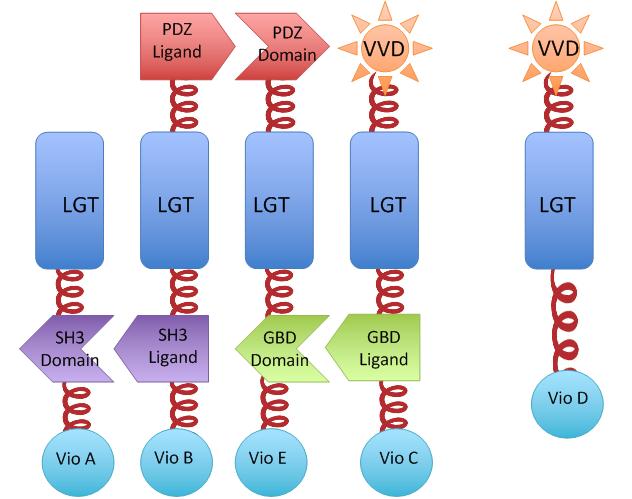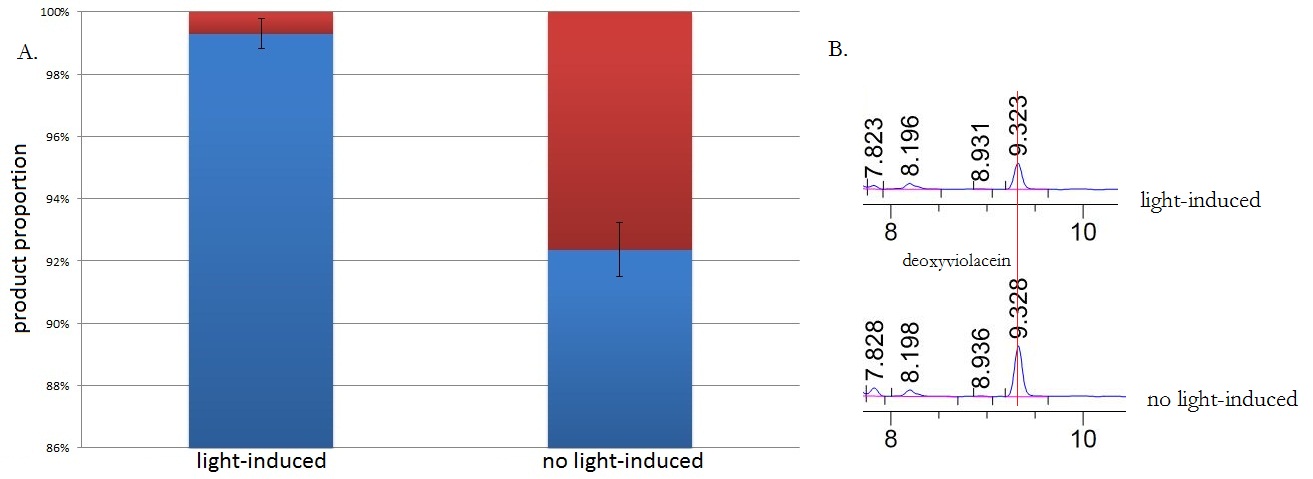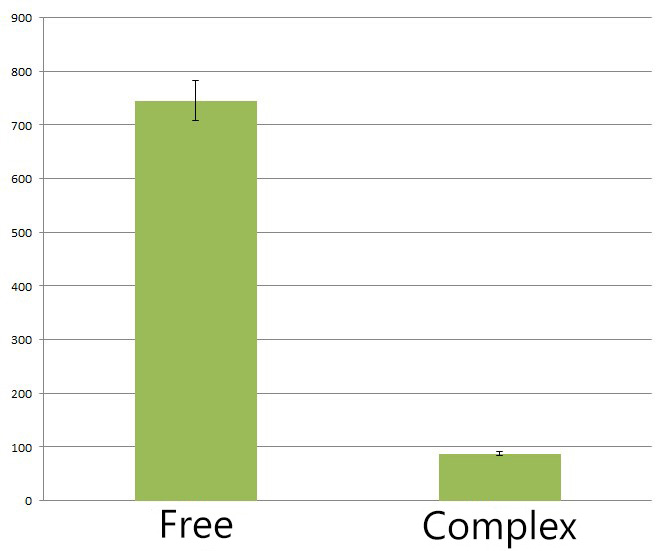Team:SJTU-BioX-Shanghai/Project/project2.1
From 2012.igem.org
(Difference between revisions)
(→Switch Analysis) |
Zhiantinglan (Talk | contribs) (→Biosynthesis - Violacein) |
||
| Line 62: | Line 62: | ||
To quantify the practical effect of photo-inducing direction alteration, we set a control group and conducted experiments as designed.There was no other difference but one that the control group was induced under absolutely no light signal. | To quantify the practical effect of photo-inducing direction alteration, we set a control group and conducted experiments as designed.There was no other difference but one that the control group was induced under absolutely no light signal. | ||
| - | [[File:12SJTU Vioconstructionetpathway.jpg|center|600px|thumb|''Fig 2'':The violacein Rudder construction. The arrows illustrate the reaction flow.]] | + | [[File:12SJTU Vioconstructionetpathway.jpg|center|600px|thumb|''Fig.2'' :The violacein Rudder construction. The arrows illustrate the reaction flow.]] |
===Suppression over side-reactions=== | ===Suppression over side-reactions=== | ||
| Line 78: | Line 78: | ||
The switch of the reaction can be realized by the extracellular signals. Through the light induction, the reaction producing deoxyviolacein by vioC alone is inhibited due to the lack of interaction with PVA. On the other hand, as long as light is restrained from the bacteria, however, the above reaction is initiated leading to the production of deoxyviolacein. | The switch of the reaction can be realized by the extracellular signals. Through the light induction, the reaction producing deoxyviolacein by vioC alone is inhibited due to the lack of interaction with PVA. On the other hand, as long as light is restrained from the bacteria, however, the above reaction is initiated leading to the production of deoxyviolacein. | ||
| - | [[Image:12SJTU_vio_propotion2.jpg|thumb|700px|center|''Fig.3'' HPLC result (right) and the ratio(left) of deoxyviolacein in sample with light induction and without light induction. HPLC results indicate that the amount of the deoxyviolacein increases greatly from the sample with light induction to sample without light induction. The red part in the chart represents the portion of deoxyviolacein and the blue part represents violacein]] | + | [[Image:12SJTU_vio_propotion2.jpg|thumb|700px|center|''Fig.3'' :HPLC result (right) and the ratio(left) of deoxyviolacein in sample with light induction and without light induction. HPLC results indicate that the amount of the deoxyviolacein increases greatly from the sample with light induction to sample without light induction. The red part in the chart represents the portion of deoxyviolacein and the blue part represents violacein]] |
The HPLC results show that the peak of deoxyviolacein appears at about 9 minutes after the injection. We find out that under the induction of light, production of deoxyviolacein was inhibited (less than 1%) while most products were violacein. Without the light induction, however, the pathway leading to the deoxyviolacein was initiated and thus deoxyviolacein was produced(about 8%). Such results confirmed our membrane rudder system and indicated that by controlling the extracellular signal, such as light, we are able to manipulate the branched chain reactions thus producing the target products we desire. | The HPLC results show that the peak of deoxyviolacein appears at about 9 minutes after the injection. We find out that under the induction of light, production of deoxyviolacein was inhibited (less than 1%) while most products were violacein. Without the light induction, however, the pathway leading to the deoxyviolacein was initiated and thus deoxyviolacein was produced(about 8%). Such results confirmed our membrane rudder system and indicated that by controlling the extracellular signal, such as light, we are able to manipulate the branched chain reactions thus producing the target products we desire. | ||
| Line 87: | Line 87: | ||
Membrane complex system would help to reduce the amount of side-products to some extent. Under the case that the enzymes involved in the side reaction are situated in the cytoplasm, they are less competent than the core enzymes attached on the membrane to mediate the subsequent reactions due to the spatial obstacle. | Membrane complex system would help to reduce the amount of side-products to some extent. Under the case that the enzymes involved in the side reaction are situated in the cytoplasm, they are less competent than the core enzymes attached on the membrane to mediate the subsequent reactions due to the spatial obstacle. | ||
| - | [[Image:12SJTU_Virdrans_before_after.jpg|thumb|600px|center|''Fig. | + | [[Image:12SJTU_Virdrans_before_after.jpg|thumb|600px|center|''Fig.4'' :The HPLC peak aera of deoxychromoviridans from sample with light inducation and RBS-vio control group. ]] |
From the HPLC results, we detected a distinct decrease of side-products deoxychomoviridans. Judging from the peak area, we find out that the amount of deoxychromoviridans from rbs-vio control group is nearly eight times that from light-induced group. Such experiment results coincided with our anticipation and demonstrated that the membrane complex system would enhance the usage of substrates and thus reduce the amount of intermediate products and other subsequent side-products. | From the HPLC results, we detected a distinct decrease of side-products deoxychomoviridans. Judging from the peak area, we find out that the amount of deoxychromoviridans from rbs-vio control group is nearly eight times that from light-induced group. Such experiment results coincided with our anticipation and demonstrated that the membrane complex system would enhance the usage of substrates and thus reduce the amount of intermediate products and other subsequent side-products. | ||
Revision as of 22:11, 26 September 2012
 "
"



